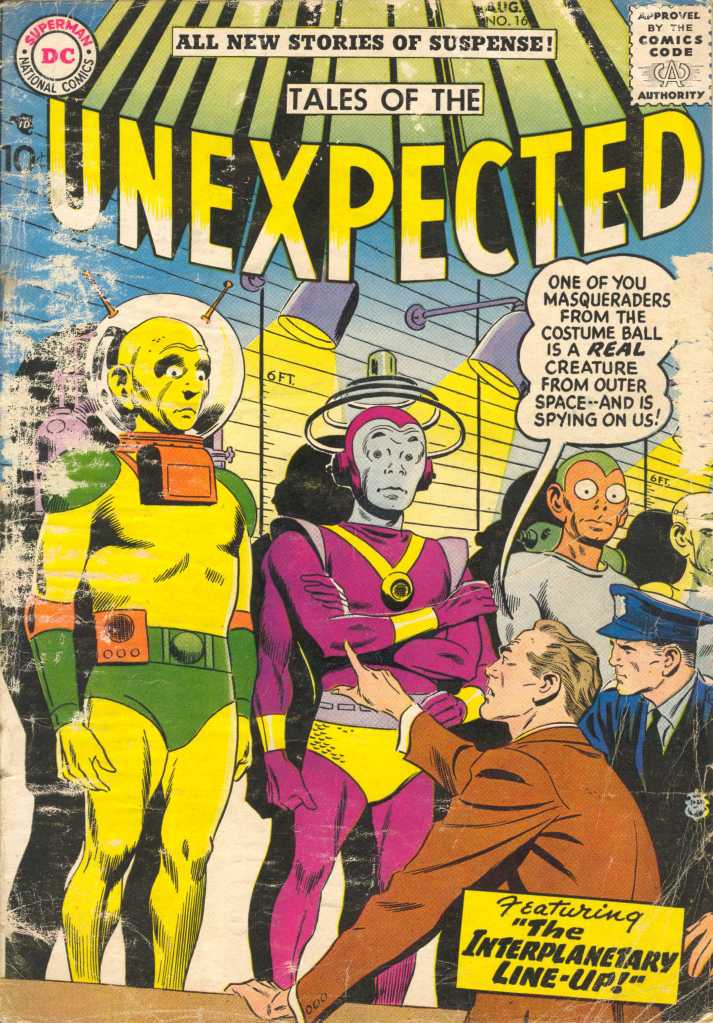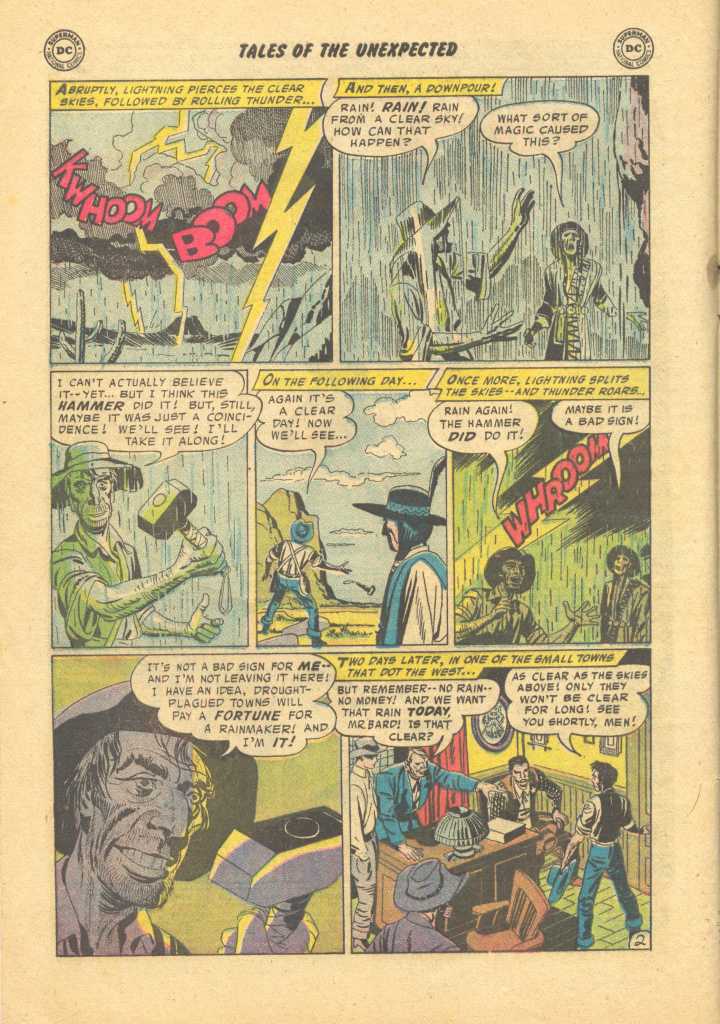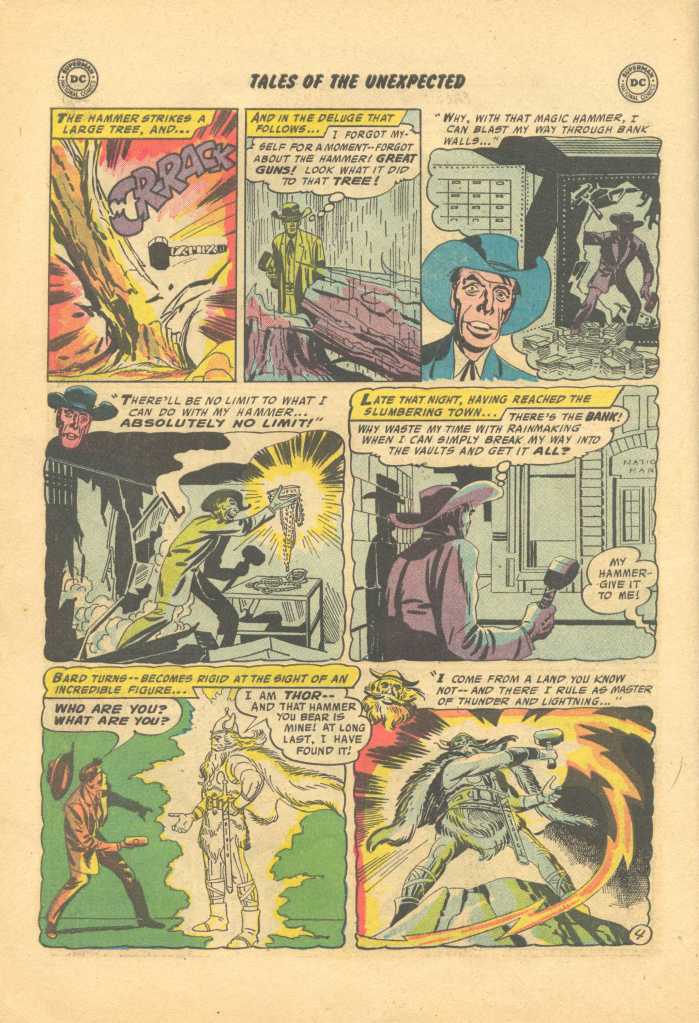
It’s no great secret that Thor was one of the earliest super heroes introduced during the beginnings of the Marvel Age of Comics, and that it was likely Jack Kirby who first proposed the idea of making a super hero out of an ancient god. Kirby had an abiding interest in mythology and in folk tales of all kinds, and so he evoked the legends of Thor on a number of occasions. By that same token, as a mythological figure, Thor and his iconography would also show up in assorted stories by others, so the provenance isn’t completely clear. But one of the more compelling bits of evidence for Kirby as the driving force behind the creation of the character is hidden in this random issue of DC’s TALES OF THE UNEXPECTED from 1957.

“The Magic Hammer” was both penciled and inked by Kirby, and likely plotted by him as well. No credit is known for the scripter, but the use of language isn’t consistent with Kirby’s syntax, so it it doubtful that the copy was done by him. It’s a slight fantasy tale in an anthology of slight fantasy tales. But what is interesting are the elements that it shares in common with the eventual super hero version of Thor.

The story is about a greedy man named Bard who happens across the hammer of Thor in the wilderness, and uses it to set himself up as a rainmaker before starting to consider a life of crime. But the appearance of the actual God of Thunder brings his plans and his fortune to an end. The biggest similarity here is that Kirby’s design for Thor’s hammer in this story is identical to the one the Marvel hero will eventually wield–and like Bard, Donald Blake finds the hammer abandoned in a remote place (though in Blake’s case, it has been transformed into a gnarled cane.)

Unlike both the mythological Thor’s hammer as well as that of his costumed counterpart, this hammer is not unspeakably heavy, meaning that Bard can lift and throw it as easily as any other ordinary hammer. The sequence at the end of this page and the beginning of the next is echoed in the first Marvel Thor story, in which the transformed Blake tests his power by hurling his hammer at a similar tree trunk.

And here, we get the first in-story appearance of Thor himself. It’s a much less super heroic portrayal of the character, but Kirby handles the character’s shaggy woolen cloak like he would any cape in the future, giving this Thor a bit of a heroic bearing. The copy never references gods or Asgard or anything completely mythological–in the late 1950s, DC was an extremely conservative place, fearful of calling down the wrath of the Comics Code. It’s possible and even likely that Kirby assumed that the copy would make reference to these elements, but it doesn’t. Thor is simply described as coming from “a land you know not.”

What’s more, Thor is a colossus in this story, who has had his substance made ethereal and shrunk down to the scale of a mortal as penance for having allowed Loki to steal and hide his magic hammer. Loki as depicted here is worlds away from the villain who would regularly bedevil Marvel’s Thor, but his design is in keeping with that of Thor himself. As Bard throws the hammer at the apparition of Thor, the entity begins to swell in size, his power and scale returned to him upon gaining possession of his mystic weapon once again.

And that’s it! It’s a forgettable tale apart from its connection to the later hero, but Kirby’s artwork is strong throughout it, and the coloring is pretty effective as well.

I don’t think it can be automatically assumed that just because Jack had a particular way of drawing an ancient hammer, it proves that he was the one who came up with Marvel’s Thor. Larry Lieber always wrote full script and it was he who named Don Blake, Jane Foster (Jane Nelson in her first appearance), and who coined the name ‘uru’. Surely if Jack came up with that first story, he would have named Thor’s human identity and put more of his ‘stamp’ on it. Of course, it could be that Jack said to Stan “Hey, how about doing a strip about Thor?” and that started Stan off in that direction, coming up with a plot before handing it over to Larry to flesh it out. Truth is, we’ll never know for sure, but it could have been Stan’s idea from the start. However, can either man really be credited with ‘creating’ Thor, as he existed before either of them? It’s easier (and perhaps more accurate) just to say that Marvel’s Thor was the result of Stan, Jack, and Larry, though not necessarily in that order.
LikeLike
“Why waste my time with rainmaking when I can simply break my way into the vaults and get it ALL?”
Because (as far as shown) the hammer’s magic does NOT include “make wielder bulletproof”?
Because you’re already making very good money now for virtually no work?
This is almost the reverse of the cliche “Why rob a bank when the gimmick could make someone a legit living?”. Here, he’s already making legal money “commercializing” the magic, and he decides on bank-robbing anyway. It would have been a tighter plot if the rainmaking business had proven to be seasonal, and dried up. Then he turned to crime because there was no more interest in his services, at least that would be better motivation.
I’d agree it’s very likely Kirby suggested “Thor”. But the initial Marvel version strikes me as very unKirby in terms of character. It’s an ordinary man who gets an object of power, rather than the very Kirby later Asgardian version.
LikeLike
this was not a particularly bright crook, agreed..
LikeLike
Where’s the retcon that shows it was that jerk Red Norvell who crossed over into DC? 😉
LikeLiked by 1 person
Eh, with a little re-writing – like changing ‘Thor’ to ‘Odin’ and him adding an enchantment to the hammer at the end to prevent unworthy mortals from lifting it in future- it would be easy to run this as an Untold Tales of Asgard.
LikeLiked by 1 person
Re-writing? Like changing it from what it is into something it isn’t? That can be done with just about any story, not just ones Jack worked on.
LikeLike
This isn’t Jack Kirby’s first DC Thor, that would be the Sandman villain Thor the villain from Valhalla ( a.k.a. Fairytales Fenton ) [ Adventure Comics#75 ( June 1942 ) ]. That story like one here I have copied on a USB. One thing I hate about Marvel’s Thor is that it robs him of all his siblings and his children ( his valkyrie daughter Thrud ( strength ) by Sif, sons Magni ( Mighty ) by the giantess Jarnsaxa and Modi ( Wrath ) by unknown mother — they all embody their father’s features ( strength & wrath ). There would have been no need for “Thor-Girl” had Thrud been in the Marvel Universe.
LikeLike